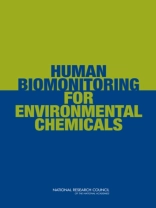Biomonitoring—a method for measuring amounts of toxic chemicals in human tissues—is a valuable tool for studying potentially harmful environmental chemicals. Biomonitoring data have been used to confirm exposures to chemicals and validate public health policies. For example, population biomonitoring data showing high blood lead concentrations resulted in the U.S. Environmental Protection Agency's (EPA's) regulatory reduction of lead in gasoline; biomonitoring data confirmed a resultant drop in blood lead concentrations. Despite recent advances, the science needed to understand the implications of the biomonitoring data for human health is still in its nascent stages. Use of the data also raises communication and ethical challenges. In response to a congressional request, EPA asked the National Research Council to address those challenges in an independent study. Human Biomonitoring for Environmental Chemicals provides a framework for improving the use of biomonitoring data including developing and using biomarkers (measures of exposure), research to improve the interpretation of data, ways to communicate findings to the public, and a review of ethical issues.
Board on Environmental Studies and Toxicology & Committee on Human Biomonitoring for Environmental Toxicants
Human Biomonitoring for Environmental Chemicals [PDF ebook]
Human Biomonitoring for Environmental Chemicals [PDF ebook]
Buy this ebook and get 1 more FREE!
Language English ● Format PDF ● Pages 316 ● ISBN 9780309663151 ● Publisher National Academies Press ● Published 2006 ● Downloadable 3 times ● Currency EUR ● ID 7148044 ● Copy protection Adobe DRM
Requires a DRM capable ebook reader












